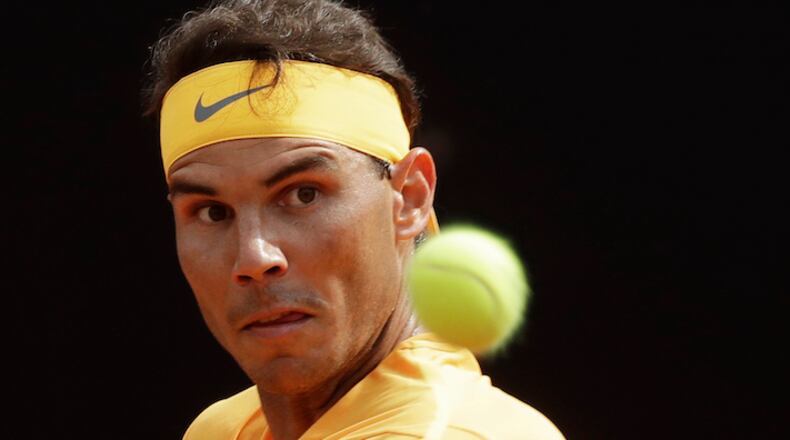The truth is that none of that matters. Focus, instead, on this indisputable fact: Even as his 32nd birthday approaches, Nadal is as dominant a figure as anyone ever has been on any surface in tennis.
So there are two ways to look at how things might unfold when play begins at Roland Garros on Sunday: Either one could be bored by the air of inevitability about what would be championship No. 11 in Paris and Grand Slam trophy No. 17 overall for Nadal — or revel in his impressive mastery. After all, there's no way to know how much longer he'll be at his best.
"I know," Nadal said, "the day to say goodbye is closer than 10 years ago."
Let's go over some of the numbers.
Nadal is 19-1 on clay this year, beaten only by No. 8 Dominic Thiem in the Madrid Open quarterfinals on May 11, ending winning streaks on clay of 21 consecutive matches and 50 sets in a row. Thiem also was responsible for Nadal's previous setback on the red stuff, at the 2017 Italian Open; the run of sets in between is the longest any man has ever accumulated on any surface, bettering the mark of 49 established by John McEnroe on indoor carpet in 1984.
Nadal is 79-2 for his career in the French Open, a .975 winning percentage.
And he is 104-2 in all best-of-five-set matches on clay, rendering those two losses to Thiem in best-of-three matches seem even more insignificant when it comes to assessing their relevance to Roland Garros.
"Rafa's mentality, in general, @ Grand Slams is maybe 1 percent, or slightly, better than everywhere else," said No. 4 Marin Cilic, the 2014 U.S. Open champion and runner-up at two of the past three major tournaments. "And I think that makes it just slightly more difficult to beat him there."
Particularly on clay, where the grind is that much greater. Rare, indeed, is the day that an opponent is able to outwork or outlast Nadal.
Novak Djokovic, a 12-time major title winner who has faced Nadal more than anyone else — 51 times — was asked whether he considers the Spaniard the overwhelming favorite for the French Open.
"You know the answer," Djokovic said.
That exchange came after he lost to Nadal in the semifinals of last week's Italian Open.
A day later, Nadal won his third title of the European clay-court swing and earned a return to No. 1 in the ATP rankings. The runner-up in Rome, No. 3 Alexander Zverev, turned to him during the trophy ceremony and said, "Congratulations, Rafa. You're the greatest clay-court player of all time."
Everyone seems to agree.
Everyone, that is, except Rafa himself.
"I don't think that I am superior to the other players," Nadal said. "Maybe some tournaments have been better than others, but that doesn't guarantee that in the future, I'm going to be better than my opponents."
The main thing that has stood in Nadal's way over the years is his body. It breaks down every so often, subjected to so much wear-and-tear, so much torque on his left wrist and so much pounding on his knees.
This year, he stopped playing in the fifth set of his Australian Open quarterfinal against Cilic because of an injured right hip that wound up keeping him off the tour for all of February and March.
That then, maybe, is why when Nadal is asked what sort of objectives he has at this point, he never mentions anything about adding to his already remarkable haul of accomplishments.
No, he has more basic aims.
"My goal is always the same thing: Be healthy. Because if I am not healthy, I cannot have any goal. (My) second goal is be happy. That's it," he said. "Then if I am healthy (and) I'm happy, I know that normally I have good chances to play good tennis."
Good might just be something of an understatement, especially when it comes to clay.
About the Author
